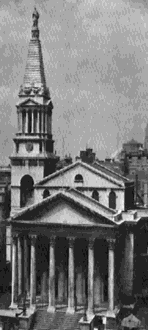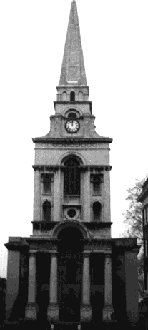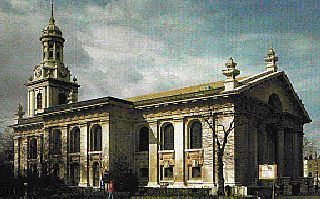
| The Hawksmoor
Churches |
 |
The eccentric architect Nicholas Hawksmoor designed a number of
Baroque churches, which were built from 1710 to 1725. His designs
were quite unusual, mixing pyramids and spires in a unique
fashion. From Sir Simon Hamilton's notes, we know that the late Luxor
Brethren identified his five churches as forming a symbol, labelled
``E.H.'' for the Eye of Horus hieroglyph they form. They identified
the points of this symbols as being:
- The Limehouse site: St. Anne's Limehouse
- The Museum site: St. Georges Bloomsbury
- The Bank site: St. Mary Wolnoth
- The Jews' site: Christchurch Spittlefields
- The Dock site: St. George's-in-the-East
- The Hospital site: St. Alfege's, in Greenwich near the Naval Hospital
- The ``Other'' site: St. John's, Horseleydown
This figure seems to form a gateway to the alternate London's which
the company has been encountering -- although it is not the only means
of passage. The Ripper murders and other events can be seen to lie
directly on the the lines which make up this Eye of Horus figure,
indicating a connection.
Sir Simon's notes also mention a bust of ``The Master'' (which turns
out to be Hawksmoore himself). Also in the notes were
as-yet-unexplained references to ``N.T.'', ``The Red Hand'', and the
date 1656. For reference, the Great Fire of London was in 1666,
and the Masons were ostensibly founded in 1717.
The Churches
- CHRISTCHURCH, SPITALFIELDS
- Regarded by most as Hawksmoor's masterpiece. Christchurch is
situated in Commercial Street, a short walk from Liverpool
St. underground station, and was built between 1714-1729 above an
old plague pit. The Spitalfields area over the centuries has
welcomed Hugenot, Jewish and Muslim immagrants among many
others. It was for this expansion that the church was built and
even today it totally dominates the area. Christchurch is a large,
solid, not particularly elegant, but still beautiful church and it
has been said that at night when the church is lit that there is
an impending sense of it falling upon you!
- ST. ANNE'S-LIMEHOUSE
- Situated near the Thames this church, built between 1712-1730,
was a well known sight for ships bringing goods up the Thames to
Limehouse docks. In 1850 the church was gutted by fire. As in the
grounds of Christchurch there is a pyramid that has no explanation
for its existence. In Limehouse there is an engraving from the Old
Testament: "A crown of glory shall be theirs, and a fair diadem
from the Lord himself." Some people see this as part Hawksmoor's
arcane influences whereby he would use ancient Greek and Egyptian
imagery in his churches.
- ST. GEORGE'S-IN-THE-EAST
- Again in the East by Ratcliffe Highway (crossroads of Cannon St)
this has a similar feel to it as St Anne's. A famous murder took
place last century, strangely enough on a spot that Hawksmoor
originally wanted the church to be built. The murderer committed
suicide and was buried at the crossroads of Canon Street and Cable
St, next to the church, with a stake through his heart.
- ST. GEORGE'S, BLOOMSBURY
- Built between 1720-1730 the most prominent part of this church is
the steeple with a statue of George I at the top. The steeple is
based on the tomb of Mausolus (hence the word mausoleum) in
Helicarnussus built in 353BC. The church was shown in Hogarth's
famous sketch 'Gin Lane' depicting drunks lolling around outside.
Writer Anthony Trollope was baptised here and the church was
mentioned in another book by Dickens.
- ST. MARY WOOLNOTH, CITY
- Hawksmoor's only church technically within the City of London
(built 1716-1724) and the smallest of his six London
churches. Built above what is now the Northern Line station at
Bank the front of this church has the appearance of two towers
fused into one mass.
- ST. ALFEGE, GREENWICH
- The first of the London churches to be built in 1712-1714 and the
only one south of the river. To save money, the surviving tower
of the old church was re-cased by John James of Greenwich. The
money to build all the churches was raised from an increased tax
on coal passed by Parliament in 1711 and originally 50 churches
were to be built in and around London.
St. Alfege's was consecrated on 29 September 1718. The church's
ceiling is the largest suspended oval ceiling in Western Europe.
The modern St Alfege's have their own
web site

St. Alfege's.
Other Works by Nicholas Hawksmoor




